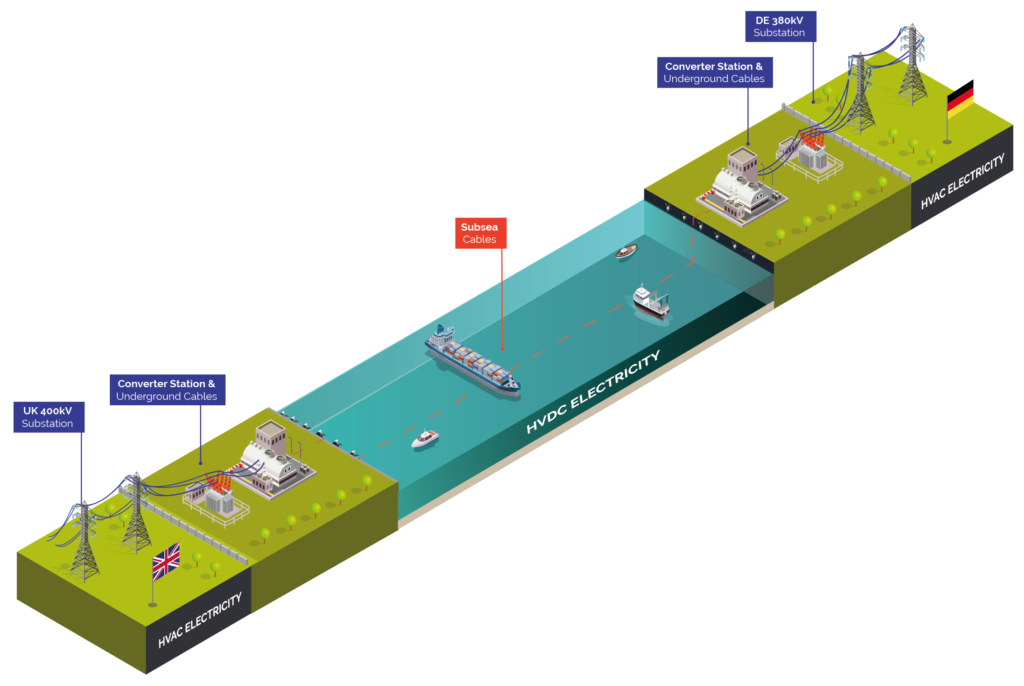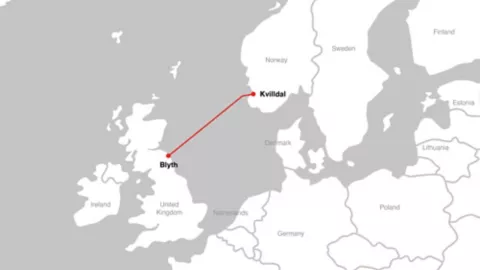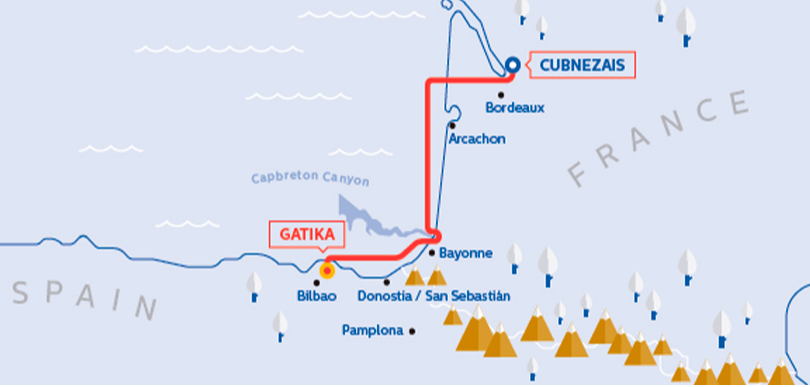NKT – NKT is preferred bidder for framework agreement including two HVDC power cable projects in Scotland
NKT is confirmed as preferred bidder for the supply of power cable systems for two HVDC transmission links by Scottish SSEN Transmission, with the intent to sign a framework agreement for future projects.
SSEN Transmission, the transmission owner in the north of Scotland, has appointed NKT as preferred bidder to provide 525 kV XLPE high-voltage direct current (HVDC) power cable systems for Western Isles and Spittal-Peterhead offshore HVDC transmission links.
NKT President and CEO Claes Westerlind says:
– We are very excited to be selected as the preferred bidder by SSEN Transmission for these two Scottish HVDC transmission links. This appointment is an opportunity to further strengthen the excellent collaboration that has been cultivated between the parties with the Caithness-Moray HVDC Link, and the ongoing Shetland HVDC Link. We also look forward to continue our support to the decarbonization of the power system in Great Britain.
SSEN Transmission Managing Director Rob McDonald says:
– Reaching preferred bidder status with NKT for the Western Isles and Spittal-Peterhead HVDC cable systems is a hugely important step to support the timely delivery of these projects. We look forward to building on our long-established and strong working relationship with NKT.
The Western Isles and Spittal-Peterhead offshore HVDC transmission links are part of The Pathway to 2030 Holistic Network Design (HND) which is a major upgrade of the electricity transmission network across Great Britain that is required to help meet UK and Scottish Governments 2030 renewable energy and climate change targets. HND sets out a single, integrated design that supports the large-scale delivery of electricity generated from offshore wind.
The parties are now proceeding with the negotiations with the intention to enter into a capacity reservation agreement providing NKT the securities needed to reserve capacity for the two named projects. Subsequently, contracts for the two projects are expected to be awarded as well as an intended framework agreement for future projects.
SourceNKT
EMR Analysis
More information on NKT: See the full profile on EMR Executive Services
More information on Claes Westerlind (President and CEO, NKT): See the full profile on EMR Executive Services
More information on Anders Jensen (Executive Vice President, Chief Technology Officer, NKT): See the full profile on EMR Executive Services
More information on SSEN Transmission (Scottish and Southern Electricity Networks): https://www.ssen-transmission.co.uk/ + We are SSEN Transmission (the trading name for Scottish Hydro Electric Transmission) and are part of the SSE plc Group.
We are responsible for the electricity transmission network in the north of Scotland, maintaining and investing in the high voltage 132kV, 220kV, 275kV and 400kV electricity transmission network.
Our network consists of underground and subsea cables, overhead lines on wooden poles or steel towers, and electricity substations. It extends over a quarter of the UK’s land mass, crossing some of its most challenging terrain.
Our first priority is to provide a safe and reliable supply of electricity to our communities. We do this by taking the electricity from generators and transporting it at high voltages over long distances through our transmission network for onwards distribution to homes and businesses in villages, towns and cities.
Our operating area is home to vast renewable energy resources and this is being harnessed by wind, hydro and marine generation. Working closely with National Grid, the GB transmission System Operator, we also enable these electricity generators to connect to the transmission system by providing their connections and allowing the electricity generated by them to be transported to areas of demand across the country.
Scotland’s transmission network has a strategic role to play in supporting delivery of the UK and Scotland’s Net Zero targets. We’re already a mass exporter of renewable energy, with around two thirds of power generated in our network area exported to demand centres further south. By 2050, the north of Scotland is expected to need 40GW of low carbon energy capacity to support net zero delivery. For context, we currently have around 7GW of renewable generation connected in the north of Scotland.
As a natural monopoly, we are closely regulated by the GB energy regulator, Ofgem, who determines how much revenue we are allowed to earn for constructing, maintaining and renovating our transmission network in the north of Scotland. These costs are shared between all those using the transmission system, including generation developers and electricity consumers.
As a stakeholder-led business, SSEN Transmission is committed to inclusive stakeholder engagement, and we conduct this at an ‘Advanced’ level as assessed by AccountAbility, the international consulting and standards firm.
More information on Alistair Phillips-Davies (Chief Executive, SSE Plc.): https://www.sse.com/who-we-are/our-leadership/group-executive-committee/ + https://www.linkedin.com/in/alistair-phillips-davies-14213871/
More information on Rob McDonald (Transmission Managing Director, SSEN Transmission (Scottish and Southern Electricity Networks)): https://www.sse.com/who-we-are/our-leadership/group-executive-committee/ + https://www.linkedin.com/in/robert-macdonald-7b723433/
More information on National Grid Electricity Transmission plc: https://www.nationalgrid.com/ + Connecting millions of people to the energy they use every day, while continually seeking ways to make the energy system clean, fair, and affordable. National Grid lies at the heart of a transforming energy system. Our business areas play a vital role in connecting millions of people to the energy they use, while continually seeking ways to make the energy system cleaner. National Grid Ventures and National Grid Partners also enable innovations to help revolutionise and decarbonise the future of energy.
More information on John Pettigrew (Group CEO, National Grid): https://www.nationalgrid.com/about-us/our-leadership-team/the-executive-committee/john-pettigrew + https://www.linkedin.com/in/john-pettigrew-ng/
EMR Additional Notes:
- XLPE:
- Cross-linked polyethylene, commonly abbreviated PEX, XPE or XLPE, is a form of polyethylene with cross-links.
- XLPE or Cross-linked polyethylene is a thermoset insulation material. Crosslinking polymers is a process which changes the molecular structure of the polymer chains so that they are more tightly bound together and this crosslinking is done either by chemical means or physical means.
- XLPE is suitable for voltage ranges from low to extra high voltage, surpassing other insulation materials such as PVC, Ethylene Propylene Rubber (EPR) and silicone rubbers. Cross-linking the polyethylene also enhances the chemical and oil resistance at elevated temperatures and makes it suitable for use as a Low Smoke Zero Halogen material.
- Grid, Microgrids and DERs:
- The power grid is a network for delivering electricity to consumers. The power grid includes generator stations, transmission lines and towers, and individual consumer distribution lines.
- The grid constantly balances the supply and demand for the energy that powers everything from industry to household appliances.
- Electric grids perform three major functions: power generation, transmission, and distribution.
- A microgrid is a small-scale power grid that can operate independently or collaboratively with other small power grids. The practice of using microgrids is known as distributed, dispersed, decentralized, district or embedded energy production.
- Smart Grid is any electrical grid + IT at all levels . Micro Grid is a group of interconnected loads and DERs (Distributed energy resources) within a clearly defined electrical and geographical boundaries witch acts as a single controllable entity with respect to the main grid.
- Distributed energy resources (DERs) are small-scale electricity supply (typically in the range of 3 kW to 50 MW) or demand resources that are interconnected to the electric grid. They are power generation resources and are usually located close to load centers, and can be used individually or in aggregate to provide value to the grid.
- Common examples of DERs include rooftop solar PV units, natural gas turbines, microturbines, wind turbines, biomass generators, fuel cells, tri-generation units, battery storage, electric vehicles (EV) and EV chargers, and demand response applications.
- HVDC Light:
- HVDC Light is the successful and environmentally-friendly way to design a power transmission system for a submarine cable, an underground cable, using over head lines or as a back-to-back transmission. HVDC Light is HVDC technology based on voltage source converters (VSCs).
- HVDC Light is designed to transmit power underground and underwater, also over long distances. It offers numerous environmental benefits, including “invisible” power lines, neutral electromagnetic fields, oil-free cables and compact converter stations.
- As its name implies, HVDC Light is a dc transmission technology. However, it is different from the classic HVDC technology used in a large number of transmission schemes. Classic HVDC technology is mostly used for large point-to-point transmissions, often over vast distances across land or under water. It requires fast communications channels between the two stations, and there must be large rotating units – generators or synchronous condensers – present in the AC networks at both ends of the transmission. HVDC Light consists of only two elements: a converter station and a pair of ground cables. The converters are voltage source converters, VSC’s. The output from the VSC’s is determined by the control system, which does not require any communications links between the different converter stations. Also, they don’t need to rely on the AC network’s ability to keep the voltage and frequency stable. These feature make it possible to connect the converters to the points bests suited for the AC system as a whole.
- HVDC (High-Voltage Direct Current):
- Key enabler for a carbon-neutral energy system. It is highly efficient for transmitting large amounts of electricity over long distances, integration of renewables and interconnecting grids, opening up for new sustainable transmission solutions.
- HVDC Links:
- The first successful HVDC experimental long distance line (37 miles) was made at Munich, Germany in 1882 by Oskar Von Miller and fellow engineers.
- HVDC allows power transmission between AC transmission systems that are not synchronized. Since the power flow through an HVDC link can be controlled independently of the phase angle between source and load, it can stabilize a network against disturbances due to rapid changes in power.
- An HVDC line has considerably lower losses compared to HVAC over longer distances.

- Neu Connect (the first power interconnection between Great Britain and Germany): https://neuconnect-interconnector.com +
- The NeuConnect Interconnector will create the first direct power link between Germany and Great Britain, connecting two of Europe’s largest energy markets for the first time. Around 720km of land and subsea cables will form an ‘invisible highway’ allowing up to 1.4GW of electricity to move in either direction, enough to power up to 1.5 million homes over the life of the project.

- The Tyrrhenian Link: https://www.terna.it/en/projects/public-engagement/Tyrrhenian-link +
- Connecting Sicily with Sardinia and the Italian peninsula via a double underwater cable: a new electricity corridor at the centre of the Mediterranean; the Tyrrhenian Link. At 950 kilometres long and with a capacity of 1000 MW, this is an infrastructure initiative of international significance, another step towards a more sustainable energy future. The link will improve electricity exchange capacity, facilitate the development of renewable energy sources, and the reliability of the grid.
- The overall project involves two sections: EAST from Sicily to Campania and WEST from Sicily to Sardinia.
- The East section is 480 kilometres long and connects the Fiumetorto landing point, in the municipality of Termini Imerese in Sicily, with the landing point in Torre Tuscia Magazzeno, near Battipaglia in Campania.
- The WEST section is approximately 470 kilometres long and connects the Fiumetorto landing point to the one in Terra Mala, in Sardinia.

- The Viking Link: https://viking-link.com +
- World’s longest power interconnection. the Viking Link is a 1400 MW high voltage direct current (DC) electricity link between the British and Danish transmission systems connecting at Bicker Fen substation in Lincolnshire and Revising substation in southern Jutland, Denmark.

- The North Sea Link: https://northsealink.com/ + North Sea Link is a 720 kilometre subsea interconnector linking the electricity systems of the UK and Norway. The 1400 megawatt interconnector stretches from Blyth in the UK, across the North Sea, to Kvilldal in Norway.

- The Hertel–New York interconnection line: https://www.hydroquebec.com/projects/hertel-new-york-interconnection/ + The Hertel–New York interconnection line project aims to supply clean, renewable energy to New York City. In Québec, the project involves the construction of a line that will span 57.7 km (56.1 km underground and 1.6 km underwater). This 400-kV direct current line will connect Hertel substation in La Prairie to an interconnection point in the Rivière Richelieu at the Canada–United States border.

- The Biscay Gulf Project: https://www.inelfe.eu/en/projects/bay-biscay + The electricity interconnection between Gatika (Spain) and Cubnezais (France) will be the first fundamentally submarine interconnection between Spain and France. This project will increase the exchange capacity from 2,800 to 5,000 MW, improving the safety, stability and quality of electricity supply between the two countries and also with the rest of Europe.

- The Eastern Green Link 2 (EGL2): https://www.ssen-transmission.co.uk/projects/project-map/eastern-green-link-2/ + The Eastern Green Link 2 project is a proposal to install a sub-sea high-voltage direct current (HVDC) cable from Sandford Bay, at Peterhead, to Drax in England. There is currently a large amount of forecasted generation that will require connection to the electricity network in the coming years and as such we are proposing several upgrades to the transmission network across the north of Scotland to facilitate this. The Eastern HVDC Link will play a key role in helping achieve our Net-Zero targets.



